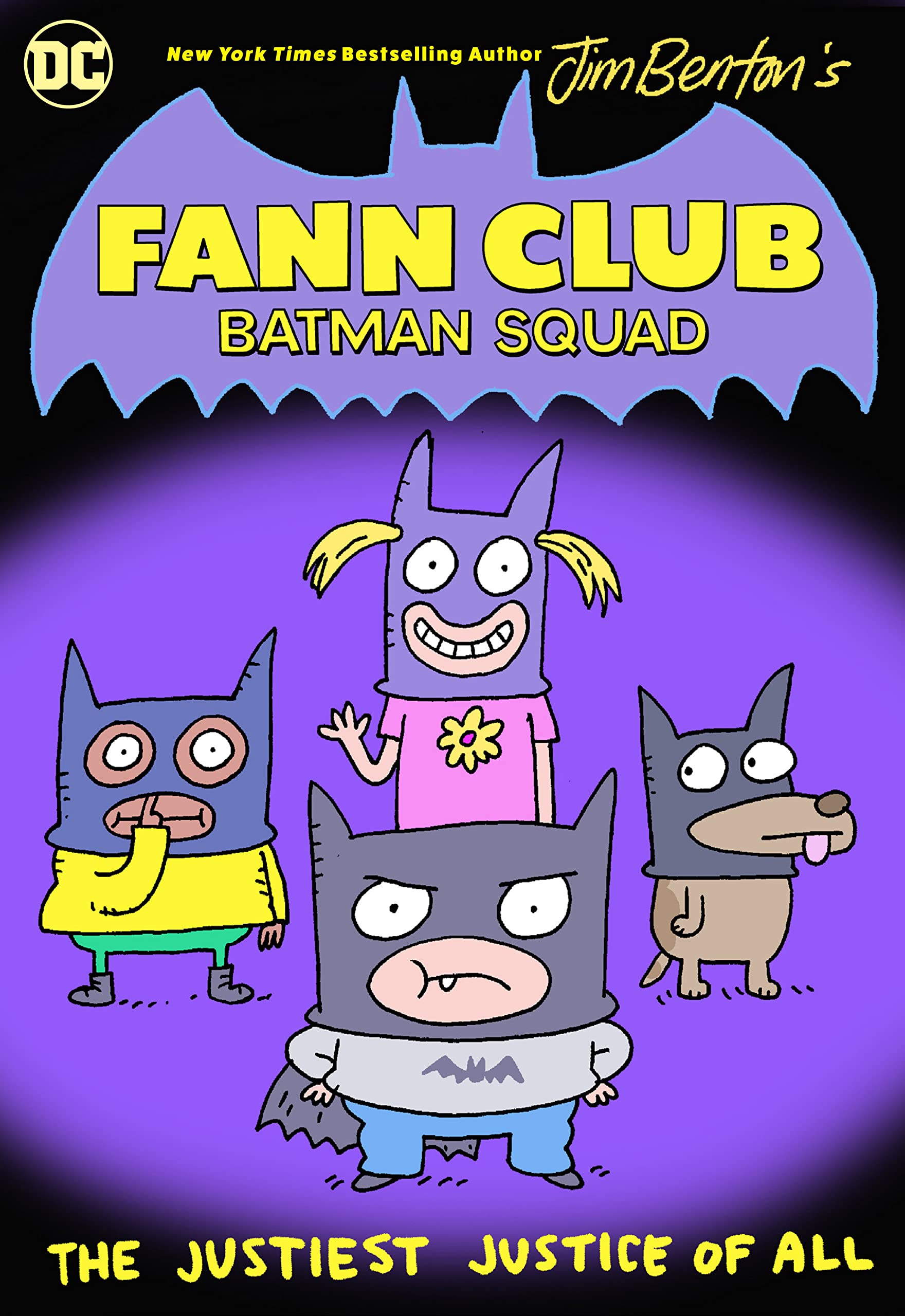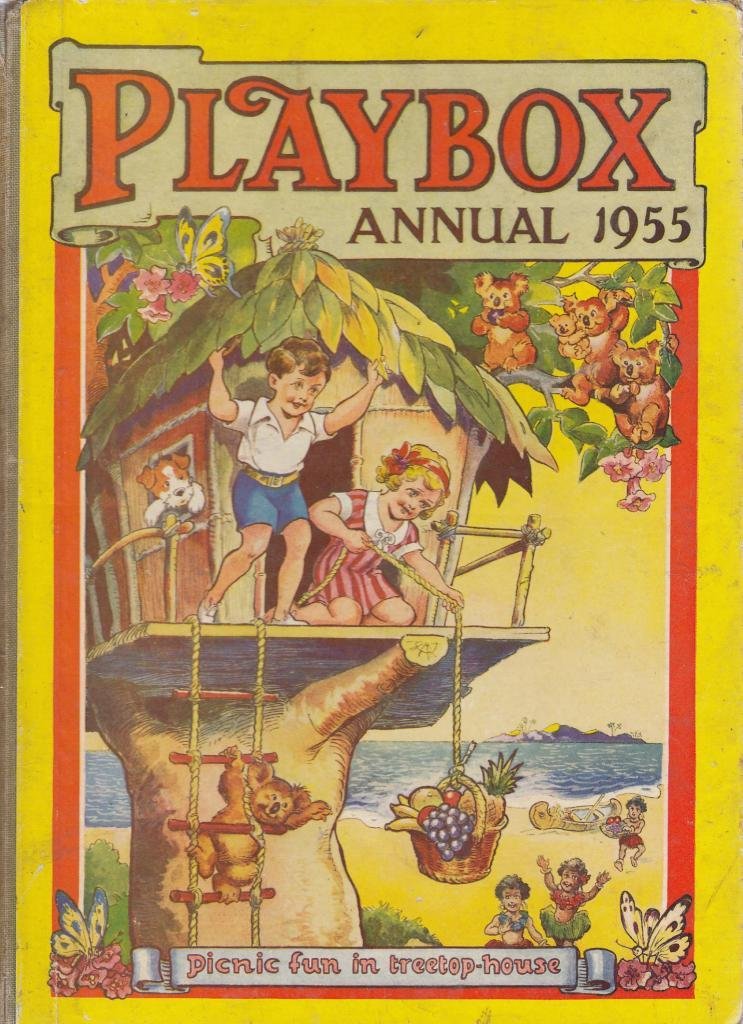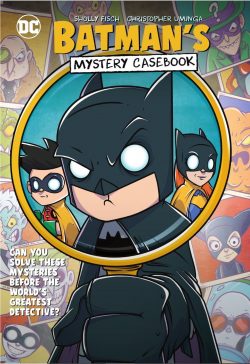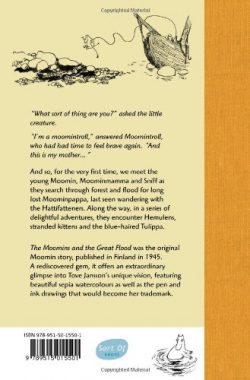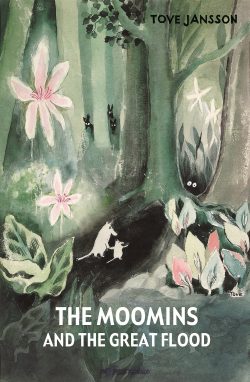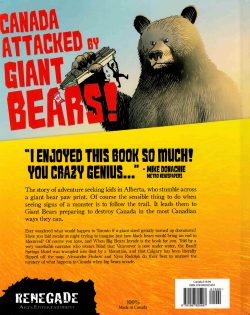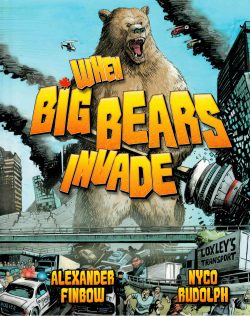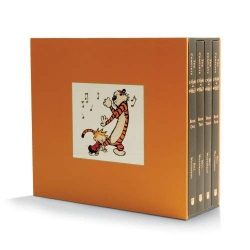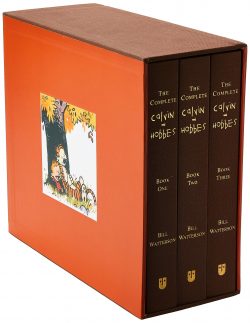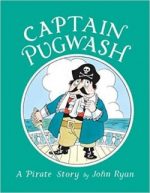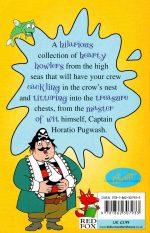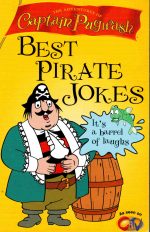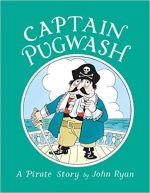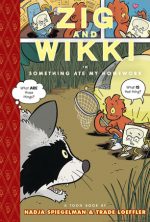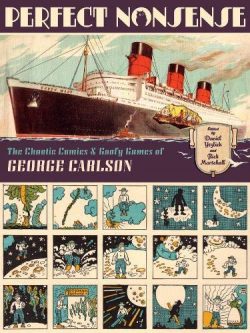
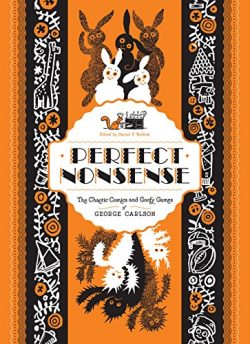
By George Carlson, edited by Daniel F. Yezbick & Rick Marschall (Fantagraphics Books)
ISBN: 978-1-60699-508-2 (HB)
The art and calling of mesmerising children is a rare one, but the masters of such an imaginative discipline – whether through words or pictures – have generally become household names.
Lewis Carroll (although that’s really two people, Charles Lutwidge Dodgson & Sir John Tenniel), Edward Lear, J.M. Barrie, L. Frank Baum, Enid Blyton, Maurice Sendak, Kenneth Graham, Arthur Rackham and their ilk, or cartoon-oriented craftsmen such as Winsor McCay, Sheldon Mayer, Theodor “Dr. Seuss†Geisel, George Herriman, Elzie Segar, S.J. Perelman, Alfred Bestall, Crockett Tubbs, Milt Gross, Carl Barks, Bill Holman and others have all garnered some degree of undying fame for their sublime cannons of entertainment, but apparently, these days, nobody remembers George Carlson.
Carlson was both unique and prolific: a surreal absurdist and sublimely stylised magician of children’s entertainments as well as a diligent commercial artist, tireless, dedicated educator, print illustrator and designer.
He absolutely loved games and puzzles and was besotted with all aspects of print media. A son of Swedish immigrants, he plied his trade(s) from New York and Connecticut between 1903 to 1962, producing everything from editorial cartoons, book jackets – including the iconic first edition of Margaret Mitchell’s Gone with the Wind – magazine illustration, typographical design, games, sheet-music, utterly unique advertising materials, books, pamphlets and so much more.
Let’s not forget comics: some of the original, eccentric and captivating comics for youngsters America or the world has ever seen…
This superb and colossal compendium, the brainchild and magnum opus of extreme fan Daniel Yezbick, is the result of 15 years toil, superbly detailing every aspect of the lost master’s life, stuffed to overflowing with intimate photos, wonderful anecdotes and page after page of glorious, enchanting stories, poems, puzzles and pictures that still have the power to take your breath away, no matter how old you are.
This tool of resurrection for a lost giant begins with ‘Preface: Great Gran’pa Gookel’ by Carlson’s descendent Allison Currie, and an effulgent Introduction by author, critic, historian and cartoonist R.C. Harvey who kindles the lost days in ‘A Very Admiring and Well-Plumbed Apostrophe to George Carlson, Cartooning Genius’, whilst Yezbick’s own fulsome Foreword declares ‘At Long Last, the Carnival’s Come Back’…
Firstly, Yezbick takes us through the great man’s multi-faceted career, beginning with ‘The Jolly Books of the Puzzling Private’, describing early works and the artist’s two decades writing, illustrating, designing and creating engaging and educational games and puzzles for influential children’s pulp magazine John Martin’s Book. Also heavily featured is Carlson’s first great creation Peter Puzzlemaker, whose visual and verbal conundrums fascinated and expanded the minds of generations of kids.
‘The Whimsical Wizard of Fairfield, Connecticut: Family Life and Commercial Art in the 1920s and 1930s’ details his most productive period, not just as a consummate long-distance entertainer of kids, but in local and publishing national arenas. For years the tireless scribbler ghosted Gene Ahern’s classic newspaper strip Reg’lar Fellers and was engaged during WWI as an army cartographer…
Whilst addressing Carlson’s lifelong fascination with transport – especially his astounding illustrations of ships and trains – ‘Gone With the Wiggily: Flirting with Fame in the 1930s and 1940s’ covers the infamous Mitchell cover-creation and other book jackets, as well as Carlson’s far more lasting and influential contributions to children’s literature.
Most important of these are his superb illustrations for Howard R. Garis’ ubiquitous and bucolic tales of venerable rabbit grandfather figure Uncle Wiggily and the artist’s wholly originated series of Puzzles, Fun Things to Do, Play and Colouring books, as well as a succession of “How to†books disclosing the secrets of drawing and creating your own cartoons.
The origin of his short but incredible funnybook career is covered in ‘The Road to Pretzleburg: George Carlson and Self-Destructing Comic Book Narrative’ and the latter disappointing years of changing public tastes in ‘Slouching Towards Fumbleland: The Restoration of the Whifflesnort’ which prompted his just-too-soon abortive creation of graphic novels (in 1962) with the never published Alec in Fumbleland plus the artist’s immortalisation as the creator of a series of images locked in a time capsule that won’t be opened until 8113AD…
The major portion of this sturdy compendium is taken up with hundreds of astounding reproductions of Carlson’s vast and varied output, beginning with ‘Early Works and Illustrations’, including scenes from numerous classical tales such as Icarus, Neptune and Amphitrite, Aesop’s Fables, The Legend of Sleepy Hollow, Tom Sawyer and full colour cover and plates for such books as The Magic Stone, Uncle Wiggily, The Prince Without a Country and more…
Also included are examples of ‘Adult and Genre Works’ such as Broncho Apache, Death on the Prairie and Scouting on the Mystery Trail…
‘Pulps, Poems and Pixies: John Martin’s Books’ offers a treasure trove of images and designs from Carlson’s 20-year tenure as contributing editor on America’s premiere pulp publication for children.
A master of what we now call paper and print technologies, with the budget and freedom to go wild, he concocted covers, frontispieces, book plates, Holiday editions, graphically integrated poem pages, astounding layouts, games pages, riddles, nonsense word glossaries, animal alphabets and so many other ways to educationally enthral, engage and stretch growing minds…
The artist was also a brilliant composer of clever, witty limericks, odes, riddles, gags and brainteasers: an advocate and devotee of whacky word play in the manner of Lear and Carroll. ‘Carlson’s School of Nonsense’ catalogues many of his most impressive cartoon-garnished confections whilst ‘Jolly Books’ displays his creations and tales for premium pamphlets (a forerunner of comicbooks) commissioned as give-aways by department stores, all dutifully crafted and packaged by the John Martin team.
As the magazine refused to carry straight advertising – feeling it was an abuse and betrayal of their young readers’ trust – Carlson and brilliant co-editor Helen Waldo devised a sponsorship method which name-checked at one remove selected backers and commercial interests through ingenious story-puzzle pages, rebuses, acronyms and acrostics…
Once upon a time, paper and printing were the internet: a nigh-inexhaustible, readily available resource providing stories, games and puzzles, information and diversions which only required a creator’s imagination and ingenuity. There was nobody more skilled, adept or inspired than Carlson, whose life-long fascination with language, crosswords, puns, riddles, rebuses, maths, wordplay and graphic invention seemingly occupied every non-working, waking moment.
He also knew music (his wife Gertrude was a professional pianist and gave lessons from their home) and here ‘Songs, Games and Other Pastimes’ displays his charming amalgamations of graphics and terpsichorean instruction, as well as science-based features, articles and books. ‘Tutorial Cartooning and Art Instruction’ offers concrete examples of the artist’s many years of publishing tracts and tomes intended to teach young and old alike the fundamentals of narrative art before ‘Trains and Transportation’ reveals in spectacular detail Carlson’s fascination with engineering, locomotives and all aspects of shipping – including the revolutionary, mindboggling Queen Mary Comparisons – after which ‘Portraits, Presidents and Personalities’ displays a selection of his superb commemorative images whilst ‘Adventures in Advertising’ shows his unbelievable versatility in putting across ideas and selling. This includes many examples of those aforementioned John Martin stealth ads, plus a plethora of delightful make-them-yourself Premiums he concocted for youngsters.
‘Original Art, Lost Works, and Forgotten Frolics’ explores tantalising might-have-beens, unearthing many treasures before the groundbreaking kids comics are highlighted in ‘Laughter, Puns, and Speed’.
Subtitled ‘The Whifflesnorting Thrills of George Carlson’s Eastern Color Comics’, a brief essay reveals the history of the illustrator’s short foray into comicbooks and the creation of legendary anthology Jingle-Jangle Comics – which launched in February 1942. Running until 1949 it headlined two features exclusively written and drawn by Carlson.
‘The Pie-Faced Prince of Old Pretzleburg’ was a manic, pun-filled procession of insane and wholesome nonsense related the fast-&-frantic screwball adventures of royal mooncalf Prince Dimwitri and his inept inamorata Princess Panetella Murphy, and a too short collection of complete capers commences here with the furiously frenetic debut from #1, in which he saves the King’s breakfast pretzel from the insidious Green Witch.
Also included are escapades from issues #11, #15, #16, #20, #35, #36 and #41, absurdist adventures in rumbling, tumbling happily tumultuous word-&-picture parables involving living jet-powered kites, assorted bandits, scurrilous scarecrows, stolen violins, fabulous beasts, living jet-mobiles, talking animals, baking, belligerent unicorns and more.
Carlson brought a deliciously skewed viewpoint to the still-evolving syllabary of comics: there are hilariously punny labels and signs everywhere and in some shots, weary birds rest on free-floating word balloons…
Without doubt, however, Carlson reserved his greatest flights of fancy for the inventive fractured fairy stories that comprised the eponymous ‘Jingle Jangle Tales’ – one-off fables starring peculiarly reinvented standbys like princesses and knights, interacting with astonishing animals and far-from-inanimate objects all imbued with a bravura lust for life and laughs.
Included here are ‘The Moon-Struck Unicorn and the Worn-Out Shadow’ from #13, ‘The Straight-Shooting Princess and the Filigree Pond-Lily’ (#22), ‘The Musical Whifflesnort and the Red-Hot Music Roll’ (#23), ‘The Rocketeering Doodlebug and the Self-Winding Horsefly’ (#25); extraordinarily mirthful mystical melanges augmented by a brace of outrageously wry spoofs of American classics ‘Skip van Wrinkle, the High-Hatted Hunter’ from #28 and impossibly raucous, breathtaking lunacy in ‘Sleepy Yollow, the Bedless Norseman’ (#31).
Harlan Ellison correctly dubbed Carlson’s sublimely inviting whimsy for the very young as “Comics of the Absurd†and these cartoon capers are urgently in need of their own complete and comprehensive collection – preferably in a lush and lavish full colour hardback archive edition…
If you have an abiding love of creative fantasy and access to pre-reading-age children (boy, that came out creepier than I imagined!), you simply must try this terrific tome and open their eyes to wonderment, enlightenment, entertainment and education in this timelessly addictively accessible chronicle.
Perfect Nonsense © 2013 Fantagraphics Books. All images and articles © their respective creators or owners. All rights reserved.
